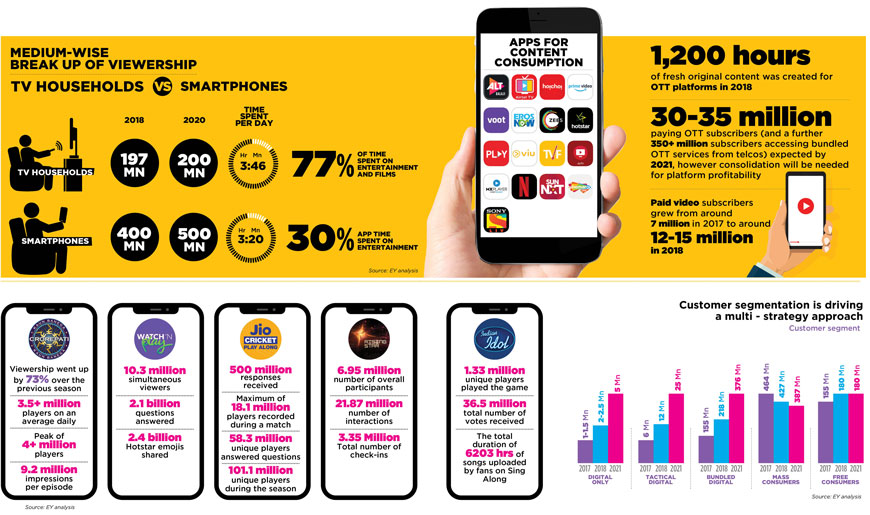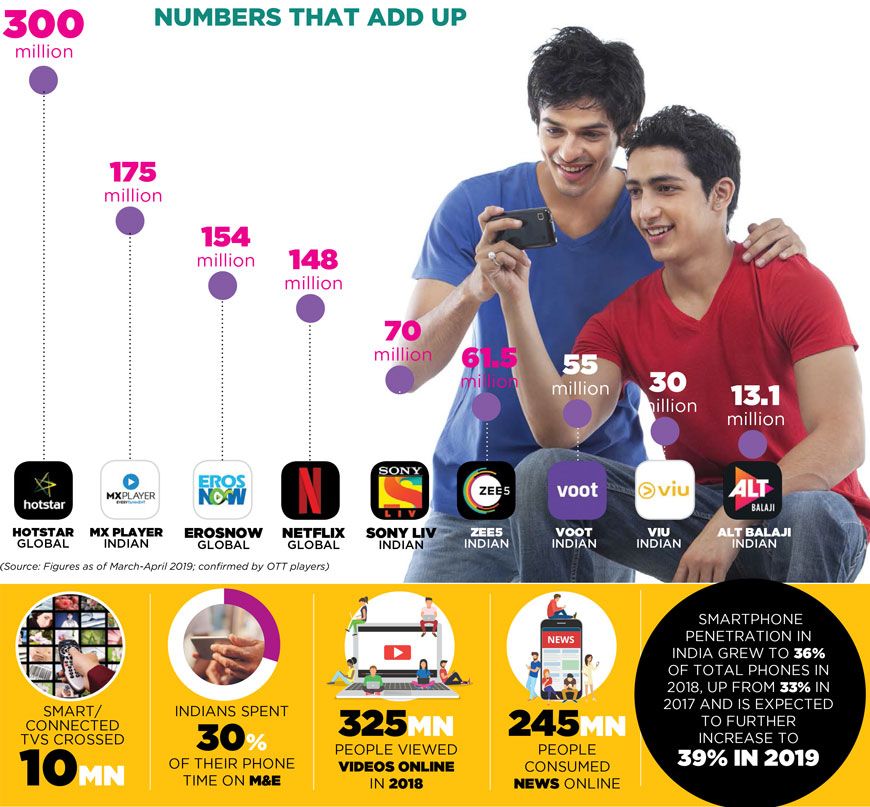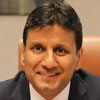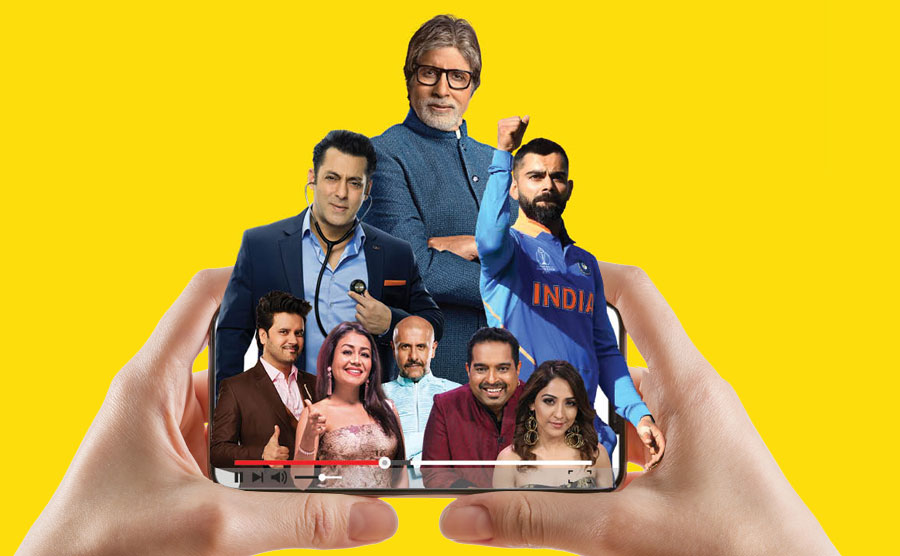TV-OTT JV: A DUAL DEAL FOR ADVERTISERS
According to an EY report, the number of people in India who consume pay TV and at least one paid OTT service is set to grow to 25 million by 2021. So how exactly have broadcasters and advertisers benefited from the second screen revolution? Some advertisers have leveraged the second screen as a feedback and measurement mechanism. This means that they can not only measure the likeability of their TV campaigns, but also in some cases, assign a revenue number generated from the campaign through online transactions.
Nina ElaviaJaipuria, Head - Hindi Mass Entertainment & Kids TV Network, Viacom18 believes that interactivity enables the broadcasters to generate more advertising revenue with TV and Digital combined. “Second screen interactivity also gives a great insight into consumption patterns, generates viewer data and also significantly increases time spent on television by providing an immersive viewing experience. The digital audience benefits linear television viewing in a big way and also drives the ratings. It is a win-win scenario for broadcasters, platform operators, advertisers and viewers.”

News reports post the Indian Premier League (IPL) 2019 matches suggest that streaming platform Hotstar had garnered over 300 million unique users and also witnessed a 74% increase in watch-time as compared to last year. According to media sources, in the on-going ICC World Cup, Hotstar has witnessed as many as eight million viewers in the matches held up to June 25, 2019. With such records being set in viewership, brands are obviously leveraging the second screen to their advantage. Hotstar has attracted sponsors like Amazon Pay, Paytm, Coca-Cola, Peter England, Yatra, Swiggy, Uber Eats, Acko, CeatTyres and ICICI Lombard offering various deals for winners while watching the matches.
No one knew about Dream11, a fantasy sports platform, before this year’s IPL season. Now, brand recall of Dream11 in the context of IPL and cricket is as high as, say, Paytm. This is attributed to its association with television, and presence on OTT platforms. According to a survey conducted on Unomer, a mobile in-app market research platform, during IPL, around the end of March 2019, 38% viewers were glued to TV and mobile both, whereas only 33% were watching IPL on TV only, and 22% were watching IPL on mobile only. This clearly shows the kind of traction both these mediums can generate for brands.
Akash Banerji, Business Head - Advertising Video Platform, VOOT talks about the brand associations around some of the platform’s interactive shows. “There has been an increased interest of advertisers such as KFC, OYO, Acko, etc., to come on board as sponsors of various interactive initiatives to reach out to this highly engaged user base,” he says. “Brands like Swiggy -which is now singularly advertising and sponsoring our KBC Kannada interactivity- or for that matter the Helo app which is associated with Bigg Boss… A lot of these brands are now not necessarily only buying inventory and are not just happy taking logo presence. They want to be very clearly an integral part of the interactivity game format that’s happening on the OTT platform space.”
However, for the majority of advertisers, the second screen has added a layer of complexity that needs to be sorted. The main challenge they face is in balancing budgets between the two screens, given that measurement metrics across the screens is completely different. Since most of their communication is focused on creating mental availability for their brands, the focus in on cost-effective reach.

That is why, earlier this year, ZEE5 announced its intent to offer measurable results for advertisers through integration with MOAT analytics, a standard verification across the digital industry that measures the viewability of video and display ads, and Nielsen Digital Ad ratings (DAR), a standard for digital ad measurements. Manish Aggarwal, Business Head, ZEE5 India says, “We now offer third-party measurable and result-oriented campaigns to our advertisers.”
For Ali Hussein, Chief Operating Officer, Eros Digital broadcasters in India are ahead of the curve from a global standpoint when it comes to direct engagement with their viewers. But, Hussein is not sure if the advertisers have adopted that engagement for a better advertising function. “I don’t think advertisers have picked up the right kind of engagement layer to their advantage,” he says.
Any broadcaster will need to look at making their content available either through a third-party platform or their own platform. Data costs may have bottomed out but viewers will take time to adapt to a new sort of viewing. “Broadcasters need to ensure that their revenues from OTT are in the same ratio as time spent on their content on Digital versus TV. This will ensure that they are able to keep track of the change in consumption patterns,” says GautamSurath, Senior Vice-President, Starcom.
OTT AND TELEVISION: LEVERAGING EACH OTHER
So how are OTT players and broadcasters leveraging each other’s presence? In case of SonyLIV, the second screen engagement has improved the targeting intelligence. With over 10-second screen initiatives, SonyLiv has a registered user base of over 20 million. Meanwhile, with around 210 million viewers tuning into ZEE channels, and a major share of that audience consuming more content on ZEE5 through the day, Prathyusha Agarwal, Chief Marketing Officer, Zee Entertainment Enterprises Ltd reveals that there is a base of 26 million consumers who are interacting with them on their social handles and their engagement extends beyond the show chatter. UdaySodhi, Business Head - Digital, Sony Pictures Networks India believes this rich pool of ‘engaged’ viewers will allow brands to leverage content interlaced with context and viewer choice, thereby enhancing the effectiveness of their campaigns.
Karan Bedi, Chief Executive Officer, MX Player links revenue generation opportunities for broadcasters and OTT players with quality content. “It would be difficult to put across numbers as far as revenue generation is a concern, but since we are an ad-driven platform, certainly revenue generated by broadcast content is quite compelling.” According to Bedi, MX Player has more than 70 million daily active users, 175 million monthly active users in India and 650 million downloads worldwide.
As an OTT player, Eros Digital with 154.7 million registered users and 18.8 million paying subscribers globally advocates the idea of a slot-based advertisement on its OTT platform than merely based on the audience profiling. Although, the cost of customer reach would become slightly expensive, eventually, the overall budget might come down due to consumer mapping. “Based on consumer psychographics, geo-location, data, etc., advertisers will be able to do hyperlocal marketing, because there will be a better understanding of subsets of consumers,” says Ali Hussein.
Hiren Gada, CEO, Shemaroo Entertainment believes innovative ways for new-age advertising is all set to increase with different formats being introduced to reach out to the consumer base for these multiple screens. The Filmi Gaane YouTube page/channel by Shemaroo tells a success story. “The total subscribers as of May 31, 2019 has been 23.7 million, wherein 1.1 million were added only in May 2019. The monthly views are around 520 million from which 85 million are unique viewers,” he says.
According to GautamMehra, Chief Executive Officer, DAN Programmatic & Chief Data Officer at Dentsu Aegis Network, second screen interactivity will not only help broadcasters understand their viewers better through the additional data that could be collected but also help keep viewers more engaged in helping drive the ratings for shows. “We see broadcasters and other content owners partnering with tech/telco companies to create some ‘never seen before’ experience for the viewers. If used wisely, the second screen has the power to create its very own loyal viewers who can continue to engage even after the end of the show.”
LARGE MEDIA COMPANIES DRIVE INTERACTIVITY
In 2018, Star, Sony, Viacom and Jio experienced tremendous success in implementing second screen interactivity. Broadcasters witnessed an increased stickiness and increase in linear viewership. OTT platforms saw an increase in app downloads and subscription numbers. Advertisers examined innovative ways to engage with customers and increase sampling. UdaySodhi says that the evolution of second-screen interactivity has opened opportunities to reach out to and engage with potential consumers for advertisers. Similarly, Nina Jaipuria affirms that second screen interactivity has helped Viacom18 channels to make a huge shift in terms of understanding viewers and catering to their needs in a more informed manner.
Second screen engagement has deepened viewer engagement with content rather than dividing their attention, she says.
In 2018, Jio along with Sony Entertainment Television, developed a play-along game for the ninth season of KBC. According to an EY White Paper on Second Screen Interactivity, viewership went up by 73% when compared to the previous season. As the show garnered 9.2 million impressions per episode, the play along engaged 3.5 million players on an average daily with a peak of 4+ million players. Last year, KBC Season 10 play-along experience, hosted on SonyLIV app, was developed by Sony itself. With HotstarWatch’N Play, Star decided to simulcast IPL on TV and Hotstar and introduced an interactive play-along app on Hotstar. As per the white paper, it witnessed 10.3 million simultaneous viewers, taking the interactivity to a new level with 2.1 billion trivia and predictive questions answered and 2.4 billion Hotstaremojis shared.
Prathyusha Agarwal says, “Interactivity helps drive brand saliency and engage in conversations with the consumers. With 28% of search queries in India being on voice and Hindi voice search queries growing at a rate of 400% y-o-y, we in fact recently integrated with the Google Voice Assistant for voting on Zee Rishtey Awards.”
LOOKING BEYOND SPORTS
Interactivity is now driving action down the funnel to create business impact. Interactivity is just not limited to a specific genre such as gaming or sport. It is now becoming more prevalent across all the genres such as music, films, fiction and devotional, benefiting viewers.
For instance, Colors Rising Star is completely based on the interactivity model wherein the audience can watch the performance live and at the same time vote for it on the VOOT app. It is an engaging experience for viewers as they can see the results of their votes on a real-time basis. According to the EY White Paper, the show in 2018 witnessed 6.95 million overall participants, 21.87 million interactions and 3.35 million check-ins. Similarly, the interactivity for Bigg Boss is also high on VOOT with engaging digital extensions like Unseen Undekha, Cutless, and Bigg Buzz—which have received a staggering response, says Akash Banerji from VOOT. “We have got close to 200 million votes on Bigg Boss Hindi and Bigg Boss Kannada. On Bigg Boss Marathi, we have curated Marathi Jatra, which is a one-stop shop for six different interactivities on the show including Chugli Booth, AaropiKaun, etc. This has seen 10 million+ interactions so far,” Banerji adds.
Apart from KBC, which has a natural slant towards interactivity, Sony has created a slew of innovative second screen experiences across their programming line-up - Augmented Reality with The Kapil Sharma Show, sing-along with Indian Idol and Voting, Virtual Opinion wall with Crossroads, co-creating content for DusKa Dum, to name a few. In fact, for sing-along, says Sodhi, the channel has taken fan engagement to the next level. As per the white paper, SET has enabled millions of users to not only vote for their favourite Indian Idol contestants, but also to sing along with them, in partnership with Smule. The result: It witnessed 1.33 million unique players playing the game, around 36.5 million votes received and 6,203 hours of songs uploaded by fans on sing-along.
Meanwhile, devotional content-based apps and shows are also attracting millions of viewers. Shemaroo’s live telecast of Lalbaugcha Raja enabled viewers to enjoy Live Darshan on their TV by subscribing to the devotion service from their DTH operators and simultaneously, the live telecast was made available on Shemaroo Bhakti app.
Hiren Gada says, “Our endeavour for the past few years has been to create services and properties that reflect the passion of the emerging digital audience. The good news is that technology is helping to bridge the gap between content owners and the audience, thus benefitting everyone including advertisers.”
That said, for MX Player’s Karan Bedi, if a broadcaster has the ability to engage its viewers with branded content, then it’s a ‘good deal’ for advertisers and OTT players. “These days, independent Indian OTT players are exploring interactivity content that can directly connect with the viewers, for example, Netflix’s interactive shows, on the adventure, animation, horror and thriller,” says Bedi.
Today, viewers can have their cake and eat it too. They share their dining tables and living rooms with the content on television, satisfying the craving for a new story and the first bite and savour the emotion and relationship with characters every day. They then stretch it across multiple screens and interactions, bingeing on it, dipping in, dipping out and gorging on it through time and space. Long live content across screens!
HOW THE SECOND SCREEN BENEFITS BROADCASTERS
• Differentiates the brand
• Increases time spent on TV by upto 50%
• Monetization through second screen sponsorships
• Generate viewer data and better understand their content consumption preferences
• Build immersive experiences for viewers which increases loyalty to content
WHY DOES SECOND SCREEN INTERACTIVITY WORK?
Social Acceptance:
Second screen engagement can be used as a tool for social communication, by allowing users to share their scores, opinions, leaderboard, level-ups
Lean Forward:
With reality shows only selecting a handful of contestants to play on each show, the second screen offers viewers the experience of participating on the show from the comfort of their homes
Immersive Experience:
The TV audience’s experience is enhanced, they are playing the game/performing alongside their favourite contestants and in front of the show host or judges. This is a far more intimate form of escapism
MARKETERSPEAK
‘Second screen helps us optimise media spends and reach our TG in a cost-effective manner’
 The second screen is now the primary screen for many consumers, especially for the cord cutter generation (consumers who don’t have/or with discontinued TV connections). Second screens gives marketers the ability to precisely target consumers with their communication and ensure high brand recall. The benefit that we have derived is that it helps us diversify and make our media spends efficient in terms of reaching our TG in a cost-effective manner. There is potential to dramatically optimize marketing spends given that the brand objectives are carefully understood and the role of this medium in the overall media plan for the campaign is clearly defined.
The second screen is now the primary screen for many consumers, especially for the cord cutter generation (consumers who don’t have/or with discontinued TV connections). Second screens gives marketers the ability to precisely target consumers with their communication and ensure high brand recall. The benefit that we have derived is that it helps us diversify and make our media spends efficient in terms of reaching our TG in a cost-effective manner. There is potential to dramatically optimize marketing spends given that the brand objectives are carefully understood and the role of this medium in the overall media plan for the campaign is clearly defined.Sanjeev Mantri
Executive Director ICICI Lombard General Insurance
‘We expect more opportunities for our brand to use the second screen to seed our messaging’
 The second screen market has become a bigger consideration for marketers as this cross device approach has great potential in driving higher conversations and involvement. We are retargeting our potential buyers by reinforcing the message emanating from our TV advertisements and coming up with personalized content that is very effective. With increasing Smart TV penetration, we expect more opportunities for our brand to use the second screen to effectively seed our messaging.
The second screen market has become a bigger consideration for marketers as this cross device approach has great potential in driving higher conversations and involvement. We are retargeting our potential buyers by reinforcing the message emanating from our TV advertisements and coming up with personalized content that is very effective. With increasing Smart TV penetration, we expect more opportunities for our brand to use the second screen to effectively seed our messaging.Sharat Dhall
Chief Operating Officer (B2C) Yatra.com
‘A holistic TV+Second Screen planning can deliver minimum 10-15% savings’
 As Uber, with our World Cup campaign ‘Every Fan Wins’, we have tapped into the Multi-screen interactivity behaviour to not only maximize our reach with our target audience but also solve dual-objectives on building brand awareness as well as business. While TV has helped us communicate our brand narrative through video formats and help build brand awareness & preference, platform first digital static & GIF CTA driven creative assets on second screen through Facebook, YouTube, HotStar, etc., have helped us shorten the ‘awareness to trial/purchase’ customer journey. A holistic TV+Second Screen planning has the potential to deliver minimum of 10-15% savings through reduced audience overlap across TV and second screen while at the same time deliver 15-20% incremental reach by advertising on both Star Sports &Hotstar.
As Uber, with our World Cup campaign ‘Every Fan Wins’, we have tapped into the Multi-screen interactivity behaviour to not only maximize our reach with our target audience but also solve dual-objectives on building brand awareness as well as business. While TV has helped us communicate our brand narrative through video formats and help build brand awareness & preference, platform first digital static & GIF CTA driven creative assets on second screen through Facebook, YouTube, HotStar, etc., have helped us shorten the ‘awareness to trial/purchase’ customer journey. A holistic TV+Second Screen planning has the potential to deliver minimum of 10-15% savings through reduced audience overlap across TV and second screen while at the same time deliver 15-20% incremental reach by advertising on both Star Sports &Hotstar. Manisha Lath Gupta
Marketing Director Uber India & South Asia
























